If you have ever walked around a garden in the summer, the chances are you have seen small, green or brown lizards. Garden lizards are very common and are also sold as pets.
Green anoles, fence lizards, and agamas are all popular species found in gardens and households.
Feeding a lizard is very simple once you learn what they eat and their dietary needs. Despite over 6,000 different species, lizards all fit into one of four feeding groups.
Continue reading to find out when and what to feed baby, wild and pet garden lizards.
What Do Lizards Eat?
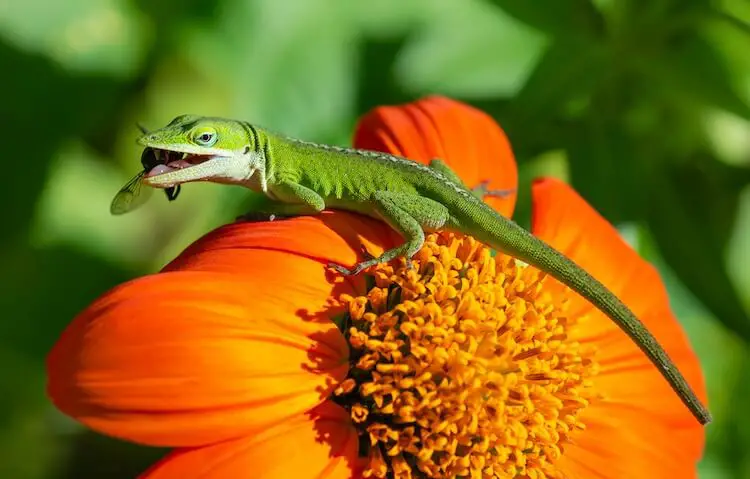
Lizards will eat anything from leafy greens to insects. They are an extremely diverse group of reptiles and have different ranges, lifestyles and ways of hunting. Even a single species, that shares a small range, can have different hunting styles. Yet one thing all lizards share is that they fit into one of four feeding groups.
Most pet lizards, like leopard geckos, anoles, and house geckos, are insectivores. This means they only eat small insects and invertebrates. In the wild these lizards hunt flies, crickets, grasshoppers, moths, ants, and other small insects. As pets they usually eat crickets, roaches, or mealworms.
Some species, like bearded dragons, blue-tongued skinks and crested geckos, are omnivores. This means they have a diet of both plants and meat. The ratio of plants to meat can range from 10 to 80% depending on the species. Omnivorous lizards eat eggs, small animals, leaves, berries, grasses, and fruits. They need a lot of variation in their diet to stay healthy.
Finally, there are herbivorous and carnivorous lizards.
Herbivores only eat plants. They are very rare and less than 3% of all lizards are herbivores. The green iguana is one of the only pet lizards that is an herbivore.
Carnivorous lizards are not as rare as herbivores, but are rare compared to insectivores and omnivores. Carnivores only eat meat such as mice, rats, large insects, rabbits, or fish. The largest lizard in the world, the Komodo dragon, is a carnivore that eats deer and pigs.
Regardless of their feeding group, wild lizards typically eat less frequently than pets and spend most of their time in search of food. Pets have all their dietary needs provided for them and eat higher quality food than wild species.
Feeding Lizards
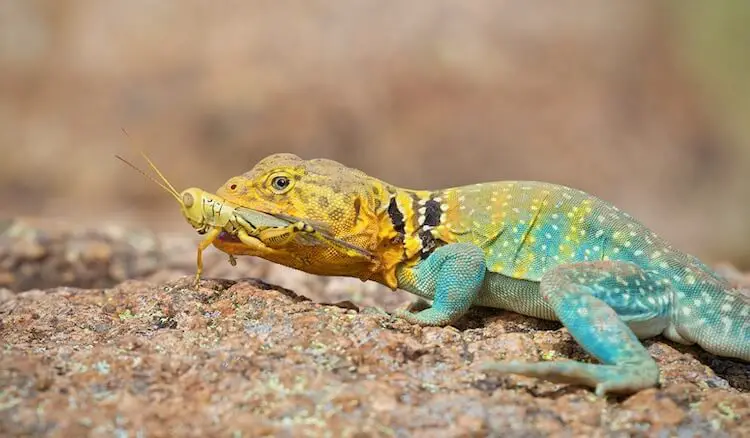
A balanced diet is important to keep wild and pet lizards healthy. Prey and food variation provide different sources of nutrition and enrichment.
Their diet also change as they need different amounts of nutrients depending on their life stage. A good example is Baby lizards. They eat more food (proportional to their body weight) than adults as they are rapidly growing.
What Do Baby Lizards Eat?
A proper diet is very important for young lizards. Over their first few months they are developing their muscular and skeletal systems. Baby garden lizards usually eat insects and only a few fruits and vegetables. Flightless fruit flies, pinhead crickets, and bottle fly spikes are the best insects for baby lizards.
Baby lizards are growing faster than adults and need to eat more often. Their smaller size also means they cannot eat the same prey as adults and cannot go as long without eating.
Hatchling garden species of all sizes should be fed every day.
Their feeding frequency can only be decreased once they reach three months of age.
Feeding baby lizards is the same as feeding any reptile. But, because they aren’t as good at catching live prey, they should be fed from a small bowl or dish. This makes it easier for your lizard to hunt, prevents prey from escaping, and lets you keep track of how much they eat. You should also make sure all prey is smaller than the space between their eyes as this will prevent choking.
The exact amount of food will vary based on species, sex, and growth rate. But, using a feeding schedule is a helpful aid.
Below is an example of a healthy diet for any baby lizard:
| Day | Food |
|---|---|
| Monday | 5-6 pinhead crickets |
| Tuesday | 3 bottle fly spikes, 6 flightless fruit flies |
| Wednesday | 5-6 pinhead crickets |
| Thursday | – |
| Friday | 3 bottle fly spikes, 3 small mealworms |
| Saturday | 5-6 pinhead crickets |
| Sunday | 3 bottle fly spikes, 6 flightless fruit flies |
What Do Wild Lizards Eat?
The term ‘garden lizard’ is an umbrella category for many small species of lizard that can be found living in gardens and homes. These lizards are mostly insectivorous and eat flies, ants, crickets, spiders, and larvae. Waxworms, butterworms, and hornworms can be fed as treats.
Many wild lizards are easy to feed and are actually helpful to your garden as they hunt common pest invertebrates. This is very similar to Toads, they also eat pests and balance a garden’s ecosystem.
You will want to feed your garden lizard three or four times a week.
Smaller species like anoles and fence lizards should eat 2 to 5 small crickets or 2 mealworms each time. Larger species like agamas can eat 20 large crickets or 5 to 10 medium-sized dubia roaches.
Agamas are the only garden lizard that is an omnivore. In addition to the insects above, adult agamas should be fed kale and dandelion greens. Pieces of grapes, raspberries, or bananas can be fed as treats too.
Every adult should be fed appropriately sized crickets, mealworms, and dubia cockroaches. Larger food will need to be cut into pieces. It should be no bigger than the width between your lizard’s eyes.
Adult lizards should grow very slowly. Sudden, noticeable weight gain may mean you are overfeeding!
Keep an eye on your lizard’s weight and adjust feeding amounts accordingly.
See below for a feeding schedule for a small, insectivorous garden lizard:
| Day | Food |
|---|---|
| Monday | 3 small crickets, 2 small mealworms |
| Wednesday | 4 small dubia roaches, 1 waxworm |
| Friday | 3 small crickets, 2 small mealworms |
| Sunday | 4 small dubia roaches |
See below for a feeding a larger, omnivorous garden lizard (e.g. agama):
| Day | Food |
|---|---|
| Monday | 10 large crickets, 4 large mealworms |
| Wednesday | 7 medium dubia roaches, 1 large hornworm |
| Friday | 10 large crickets, dandelion greens |
| Sunday | 7 medium dubia roaches, 2 grapes (halved) |
Common Feeding Mistakes
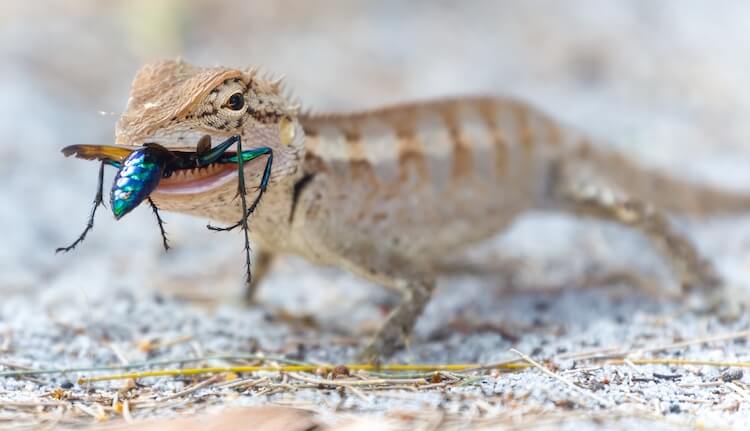
Not providing diet variation is a common mistake. It is easy to feed a lizard one or two prey items, but variation is the key to proper nutrition and enrichment. A restricted diet is very damaging to their health and can lead to metabolic bone disease and vitamin deficiencies, especially in omnivores.
It is always best to feed different foods to a lizard and rotate them throughout the month.
For example, feed your insectivore a mix of crickets and mealworms one week and roaches and crickets the next week. This will not only provide a wider range of nutrients, but will also mentally enrich them during feeding time.
Even with a varied diet, most captive lizards also require vitamin supplements to remain healthy.
Too few vitamins, especially vitamin D, can cause stunted growth and digestive and skeletal problems.
Dust food with a high-quality multivitamin and calcium powder twice a week. You can also gut-load feeder insects by feeding them fresh fruits and vegetables no more than 48 hours before they are fed to your lizard.
Finally, feeding lizards the wrong diet can result in vitamin deficiencies or even starvation.
Before feeding a lizard determine the species first. Try to understand is it an omnivore, herbivore, insectivore, or carnivore. This basic information is the best starting point for a healthy diet. Most garden lizards are pure insectivores, but some also eat fruits and vegetables.
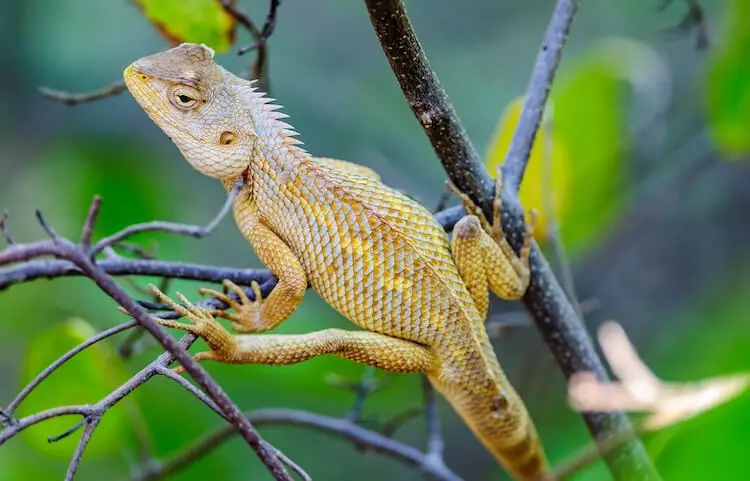
Can Lizards Eat:
Roaches: Yes. Cockroaches make up a large percentage of many wild lizard diets. Many owners like to feed dubia cockroaches, which are high in moisture, calcium, fiber, and protein. Roaches are a good, reliable food source.
Ants: Yes, but it is not part of their staple diet. Ants are small, so they must be eaten in very large numbers to have any nutritional benefit. Some species, like the horned lizard, are adapted for eating ants.
Snakes: No. Larger species like monitors and tegus may eat baby snakes, but most lizards are preyed on by snakes.
Scorpions: No. Pet lizards should not be fed scorpions. Some desert-dwelling lizards like the Western banded gecko eat scorpions. However, this is rare, and most of the time it is the other way around!
Spiders: Yes. Small spiders are prey for house geckos, skinks and anoles. In many ecosystems, lizards are important predators that regulate the number of spiders in an area.
Fruit: Yes. Fruit is an essential part of the diet of omnivorous and herbivorous lizards. In moderation, fruit is a healthy, vitamin-rich snack that many species enjoy. Insectivores will not eat fruit, even if it is offered.
Chocolate: No. Chocolate is toxic and contains theobromine, a compound that is toxic to most animals, including reptiles. Theobromine is a stimulant that overloads the nervous and cardiac systems. It can lead to death.
Vegetables: Yes. Dark leafy greens, squash, now peas, parsley, and bell peppers are all great vegetables for lizards.
Bread: No. Lizards’ digestive tracts are not meant to handle grains and large amounts of complex sugars. Bread is not nutritious and should not be offered.
Worms: Yes. Some house lizards will eat earthworms. However, because of their slimy exterior, worms are not usually eaten unless they have no other option. Other worm-like invertebrates such as hornworms, waxworms, and mealworms are loved by lizards and make excellent treats.
What Fruit Can Lizards Eat?
Fruit makes a great treat for lizards every once and a while. Use fruit as a reward, or as a way to make other foods more appetizing, such as adding chopped mango to your bearded dragon’s salad.
These fruits are both safe and tasty:
- Apples
- Bananas
- Grapes
- Papayas
- Honeydew melon
- Cantaloupe
- Kiwi
- Blueberries
- Strawberries
- Pears
- Pineapple
- Figs
- Peaches
Make sure to wash all fruits thoroughly and chop them up into bite-sized pieces before feeding them to a lizard. Discard any hard seeds, pits, or peels, and don’t feed any fruit that is moldy or not 100% safe for lizards.
Remember, only about 5% of your lizard’s diet should be fruit. Though healthy in small amounts, fruit is very high in sugar and eating too much of it can lead to health problems.
What Vegetables Can Lizards Eat?
Vegetables are the main food source for many lizards. Feeding a variety of veggies is healthy and decreases the likelihood of your reptile developing a vitamin deficiency. It also makes feeding time a more exciting and enriching experience.
Below are some common vegetables that lizards love and are known to be safe and healthy:
- Kale
- Dandelion greens
- Carrots
- Squash
- Tomatoes
- Sweet potatoes
- Endive
- Bell peppers
- Parsley
- Swiss chard
- Collard greens
- Yams
- Spinach
- Romaine lettuce
As with fruits, vegetables should be fed in moderation, along with insects.
Wash and cut vegetables into small chunks, discarding any inedible seeds or peels. Kale, romaine lettuce, and spinach should be given in small portions because they contain an enzyme that binds calcium.
What Can’t They Eat?
There are plenty of foods that are edible and safe for lizards, but there are also many that are not safe. For insectivores, only use feeder insects that are free from parasites and disease. For herbivores and omnivores, use fresh or frozen-thawed fruits and vegetables that are washed.
The foods listed below are either toxic or not nutritious for lizards:
- Iceberg lettuce
- Fireflies
- Avocado
- Juniper
- Acorns
- Eggplant
- Garlic
- Onion
- Ticks
- Celery
- Butterflies
- Caterpillars
Never feed wild-caught insects or fruits and vegetables taken directly from your garden (without washing them). Wild-caught insects may carry parasites. Fruits and vegetables can be covered in pesticides and other harmful chemicals that can lead to sickness.
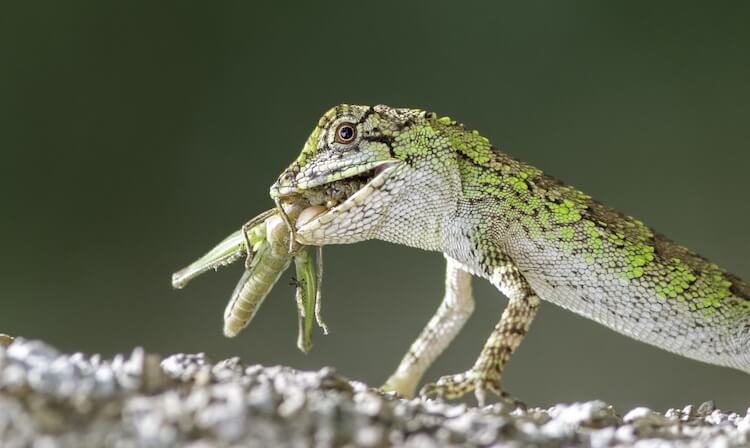
Summary
Most lizards fall into two categories: insectivores and omnivores.
Insectivores only eat insects and other invertebrates. They can eat anything from spiders, flies, and aphids to crickets, mealworms, and dubia roaches.
Some species have a diet similar to turtles and are omnivores. Omnivores eat insects too, but they also need fruits and vegetables in their diet. Safe fruits and veggies for lizards include bananas, papaya, grapes, yams, bell peppers, carrots, strawberries and dandelion greens.
Make sure you also provide your lizard with vitamin and calcium supplements twice a week and vary its diet to ensure it gets all the nutrients it requires.
What do you feed your lizard? Let us know in the comments below.

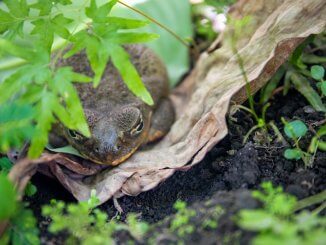
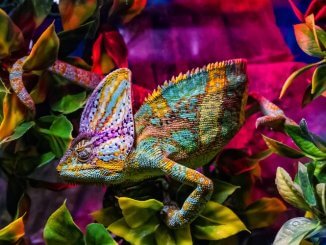
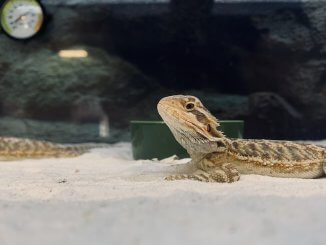
My blue iguana is approximately 1 year. It won’t eat any fruit. Loves greens and Mexican grey squash ( grated ). Any suggestions on what I can do to change this.
I’ve tried banana, strawberries , blueberries & Blackberries.
Hi Kathy, have you tried Mango?! We have some feeding tips for Iguanas in our care guide.
I have found a tiney lizard and dont know what to feed it or put in its cage
Do you know which species this is? This is quite important.
However, most small lizards are insectivorous and will eat crickets, earthworms and similar organisms. Your local pet store will have options. Once or twice a week you should supplement its food with calcium and vitamin supplements. You can try offering him small quantities of vegetables and fruits too, and see how it reacts.
What fruits and vegetables can I feed my baby oriental garden lizard?????
Please refer to our article, it has a section titled “What Do Baby Lizards Eat?” which should be perfect for your animal. Baby lizards tend to prefer insects to fruits and vegetables, but some good intermediate options would be Bananas, Grapes and Pears, or Kale, Squash and Carrot.
Hi, thanks for this really informative article. We have identified our garden lizard as possibly/probably a fence lizard and I may leave a little mango out for him to see how he gets on.
I believe the fence lizard is insectivorous, so no mango for him. Try crickets and earthworms instead.
I don’t have one I see them around my flowers all the time, and I am sceard of them
Do lizards eat lady bugs. I want to get lady bugs for a natural pesticide
Hi Frances. Lizards do eat lady bugs, especially Anole Lizards. However, they are certainly not the best meal, given their various defense mechanisms: first of all their bright color (often a sign of venom or bad taste) might deter some predators from even trying, and their hard outer shell and ability to discern a bad odor might make the ones who try think twice!